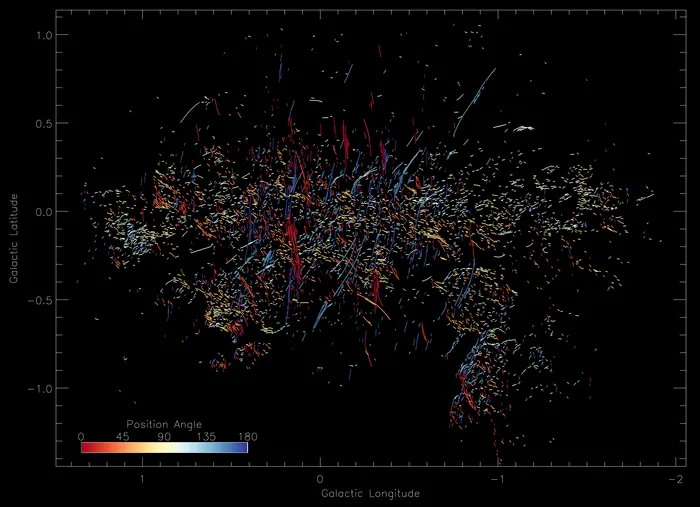
New observations from South Africa’s MeerKAT telescope have unveiled a new discovery of numerous long strands of gas, stretching for 5 to 10 light-years, reaching out from the central black hole in our galaxy.
The Space explains these strands or threads as spokes on a bicycle wheel, with the black hole at the center and the gas filaments extending outward along the plane of our galaxy. The galactic center is adorned with hundreds of these gas lines, creating a mesmerizing sight.
In a statement, Farhad Yusef-Zadeh from Northwestern University expressed surprise at the unexpected discovery of a new group of formations that appear to be directed towards the black hole.
He further explained that these filaments are not randomly scattered but rather connected to the outflow originating from our galaxy’s black hole.
Horizontal and vertical filaments might have different origins
Back in 1984, Farhad Yusef-Zadeh made a significant finding when he discovered large, slender magnetic filaments hanging at a right angle to the galactic plane near Sagittarius A*, the colossal black hole at the core of our Milky Way galaxy.
This black hole surpasses the size of our sun by over 4 million times. However, Yusef-Zadeh’s recent revelation of horizontal, thread-like filaments resembling the dots and dashes of Morse code came as a surprise.
Astronomers have discovered hundreds of mysterious cosmic threads that point towards the supermassive black hole at the heart of the Milky Way.
The strange filaments, each of which stretches five to 10 light years through space, resemble the dots.. pic.twitter.com/CiStdafERp
— April (@avril4799) June 3, 2023
Yusef-Zadeh shared that their focus has traditionally revolved around vertical filaments and their origins. He admitted to being accustomed to these filaments being vertical and had never previously entertained the possibility of their existence along the galactic plane.
Although the two types of filaments may appear similar on the surface, they are fundamentally distinct from each other. Yusef-Zadeh suspects that they originate from different sources.
Horizontal filaments being ‘6 million years old’
Yusef-Zadeh estimates that the horizontal filaments are relatively young, with an estimated age of around 6 million years.
He suggests that these filaments likely emerged from an outflow of material that occurred a few million years ago. The formation of these filaments seems to be the outcome of the interaction between the outflowing material and nearby objects.
The insights we can gain from these filaments regarding Sagittarius A* could have significant implications. In the realm of black holes, there exists a concept known as the “no-hair theorem,” coined by the renowned physicist John Wheeler.
This theorem suggests that a black hole’s characteristics can be defined by only three fundamental properties: its mass, its angular momentum (which refers to the rotational momentum or spin of the black hole), and its electric charge.
Given that black holes are not expected to possess a significant electric charge, it implies that their defining attributes boil down to just their mass and spin, disregarding other features (hence the term “no hair”), according to Space.
See all the latest news from Greece and the world at Greekreporter.com. Contact our newsroom to report an update or send your story, photos and videos. Follow GR on Google News and subscribe here to our daily email!



